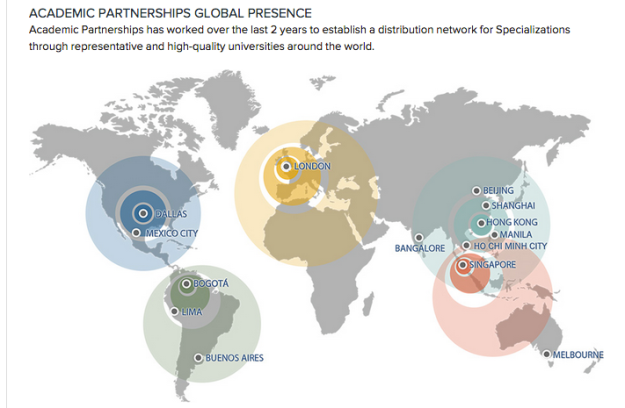This ‘Need-to-Know’ blog post series features noteworthy stories that speak of need-to-know developments within higher education that have the potential to influence, challenge and/or transform traditional education as we know it. This post was updated on July 22, 2014 to reflect clarification on the type of online courses offered by The University of Texas at Austin.
1) Massive Teaching Mess
Much has already been written about the most bizarre MOOC on Coursera to date, “Teaching Goes Massive: New Skills Required” (#massiveTeaching) developed by University of Zurich’s professor Paul-Oliver Dehaye. The MOOC has been labeled as a pedagogical experiment (though some say also a psychological), and the professor called a “lunatic”, “brilliant” and/or “stupid” (via student comments within the course forum).

“Teaching Goes Massive” (screen shot) on Cousera. Course content is no longer accessible, even to previously enrolled students (most courses provide access to content after course is complete)
I was an enrolled student and found the course odd from day one. First, there were no course goals or focus questions provided whatsoever indicating what direction the course would take. After numerous student comments, Dehaye posted his version of course goals:
Learning Goals…
– Pedagogical
– Technical
– Legal
– Business
– Societal
Brief to say the least. In fairness to Dehaye, he did state from the beginning that the entire course was an experiment, and that several experiments would be taking place within the course, “The other experiment which has been running from the start is the “Structure the Discussion Area” experiment…” and “A third experiment, which is only just starting, was initiated by courageous course participant _____ here” (excerpt from course-generated email from Dehaye on Day 2). What happened next was the catalyst for the publicity of the course, Dehaye removed all of the course content from the course site. It disappeared, no videos, announcements, no links—nothing. Then there were strange Twitter messages posted by Dehaye, and finally a of day or so later Coursera removed Dehaye from the course sending this message to enrolled students:
“We understand that the course included experimental components designed by the professor that have resulted in some course interruptions,” the statement read. “We are working with the university to make arrangements so that the course can continue to its conclusion in an appropriate manner.” Coursera
Takeaway: I agree with what appears to be the consensus, Dehaye did not do much to further constructive discussion about MOOCs, privacy or pedagogy in higher education. Though George Siemens generated quite a bit of discussion by congratulating Dehaye in his blog post. However, it was unclear what kind of statement or message Dehaye was trying to send. It had potential to be effective, but was lost.
- A Question of Quality, Inside Higher Ed
- You’ve Been Punk’d! However that was an education experience, Apostolos K. (“AK”)
- On Subversion, Maha Bali
2) University of Texas at Austin Online Courses – Correction
An earlier version of this post misrepresented the course offerings of University of Texas at Austin by suggesting the course “Topics in Globalization” would be available for credit via the edX platform. The school is not offering college credit via its MOOC courses on edX, but is offering courses for credit on their online platform via UT Austin’s University Extension program. Several courses are available on this platform that are for credit, that include American Government, Psychology Live and US Foreign Policy. For a full list of courses click here.

Screen shot of University of Texas at Austin’s web page featuring information on the offerings of its online courses. Visit online-education.la.utexas.edu
3) Pearson’s SOOCs
When reading the article on Pearson’s blog, “Will SOOCs eat MOOCs for breakfast?”, I started with a good chuckle given the cartoon featured in the opening. After reading the full post though, I wasn’t sure if the entire article was a continuation of the joke, or if it were serious. But apparently Pearson is serious. The idea of SOOCs, the article suggests, evolved during the this year’s EdTech Summit in Europe.
An evolution on the idea of MOOCs is the “selectively open online course” (or SOOC) – simply, a MOOC with an entrance requirement designed to reduce the “unwanted diversity.” This could be proven competency (e.g., pass an entrance quiz), a credential (e.g., have a degree), or membership (e.g., be in the university’s alumni network). The theory is that a more uniform student body will lead to improved peer-to-peer collaboration and higher learner outcomes.
It goes on….
Higher quality is also likely to increase learners’ willingness to pay for an online course, which in turn will increase a university’s willingness to invest in better professors, facilities, and/or pedagogy. The Harvard Business School, long a stalwart of pedagogical innovation, has taken bold steps to build its own SOOC…
Takeaway: This article (sadly) highlights the misconceptions and lack of awareness that still exists about online learning and higher education. Never mind that closed, online courses have been offered at public and private higher education institutions for well over ten years, and that the mere name SOOC, contradicts the concept of ‘open‘. Sigh.
You can keep up to date with developments in education and related sectors by following me on Twitter, @OnlineLearningI






